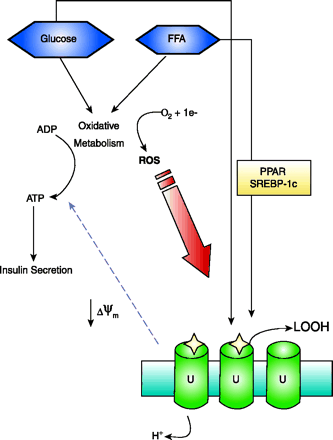
- Institution: Stanford Univ Med Ctr Lane Med Lib/Periodical Dept/Rm L109
- Sign In as Member / Individual
ROLE of MITOCHONDRIA in TOXIC OXIDATIVE STRESS

Schematic representation of the hypothesized relationship between glucolipotoxicity, ROS, and UCP2 (U) in pancreatic beta-cells. Exposure of beta cells to glucose and FFA increases expression of UCP2. Both peroxisome proliferator-activated receptors (PPAR) and sterol response element binding protein-1c (SREBP-1c) have been implicated in induction of UCP2 transcription. Oxidative metabolism of glucose and FFA generates ATP. ROS such as superoxide are a by-product of oxidative phosphorylation, with production increasing under conditions of chronic over-nutrition. ROS-mediated activation of UCP2 (stars) lowers the mitochondrial membrane potential (ΔΨm), resulting in a decrease in ATP production to attenuate glucose-stimulated insulin secretion. Although ultimately detrimental, the activation of UCP2 is an attempt to protect beta cells from further ROS production and to export harmful lipid peroxides (LOOH) from the mitochondria.


